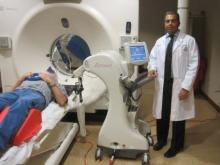MIAMI BEACH – An x-ray tube about the size of a sewing needle can safely deliver radiation to nonmelanoma skin tumors on the nose, scalp, or other highly visible areas of skin with good efficacy and good to excellent cosmetic results, an investigator reported at the annual meeting of the American Society for Radiation Oncology.
About 93% of patients treated with an electronic brachytherapy system from Xoft had cosmetic results judged to meet Radiation Therapy Oncology Group (RTOG) criteria for "excellent" at 1 year, said Dr. Ajay Bhatnagar of Cancer Treatment Services Arizona, Casa Grande.
"To date, the treatment of nonmelanoma skin cancer with electronic brachytherapy is comparable to traditional brachytherapy, with excellent cosmesis, acceptable acute toxicities, and no recurrences to date. Brachytherapy is an excellent modality for elderly patients with nonmelanoma skin cancers in cosmetically sensitive locations," he said.
The electronic brachytherapy system delivers a radiation dose to tumors equivalent to that of an iridium-192, high dose rate surface (Leipzig) applicator, but without the need for a radioisotope. The electronic device is a miniature, high dose rate, low-energy x-ray tube that produces x-rays with a maximum of 50 keV of energy.
Dr. Bhatnagar looked at data on 102 patients treated with the device for 120 nonmelanoma skin cancer lesions. All patients received 5 Gy in eight dose fractions for a total of 40 Gy delivered in two fractions per week for 4 weeks. The prescription depth, based on CT simulation, varied from 3 to 7 mm. The treatment goal was to achieve a minimum 5-mm treatment margin wherever possible.
The device was placed with the patient immobilized and wearing a flex shield that prevents excessive radiation exposure to the clinician. Skin care included application of petrolatum ointment during treatment and aloe vera gel for 1 month afterward.
Of the 120 lesions treated, 59% had basal cell histology, 36% were squamous cell, 2% were Merkel cell carcinomas, 3% were cutaneous T-cell lymphoma lesions, and 1% had a mixed basal-squamous histology.
About one-third of the lesions were on the nose, another third on the face, with the remainder on the ears, extremities, scalp, and torso.
Nearly all patients (91%) experienced an acute rash with treatment, and 25% had itching of the treatment site. The most frequent late adverse effect was hypopigmentation of the treated skin, which occurred in 11% of lesions from 3 to 6 months.
At 1 month post treatment, cosmesis was rated as excellent (no change to slight atrophy or pigment change; slight hair loss; or no changes to slight induration or loss of subcutaneous fat) in about 77% of 81 patients evaluated; the remainder had "good" cosmesis (patch atrophy, moderate telangiectasia, total hair loss; moderate fibrosis but asymptomatic, slight field contracture with less than 10% linear reduction).
Dr. Bhatnagar also launched a salvo in the turf battle between radiation oncologists and surgeons by urging his colleagues to take on more skin cancer cases. "Despite skin cancer being the most common malignancy in the world, it’s under-represented in our radiation oncology clinics. As radiation oncologists, we need to play a more prominent role in the treatment of nonmelanoma skin cancers," he said in his presentation.
A radiation oncologist who was not involved in the study commented that radiation therapy offers certain advantages over surgery when tumors are located in prominent locations, such as the face.
"We’ve been treating these lesions for close to 100 years now, and radiation does very well," said Dr. Keith A. Cengel, of the University of Pennsylvania School of Medicine in Philadelphia. "The one drawback – and I tell this to my patients when I treat with radiation – is that [subsequent] surgery can be more difficult and have a higher complication rate if you have a recurrence."
Mohs surgery, the most common form of treatment for basal or squamous cell skin cancers, may itself leave a comparatively deep and wide wound that may not heal as smoothly as a radiation-treated lesion, he added.
Dr. Cengel comoderated the session in which the electronic brachytherapy data were presented.
The study was sponsored by Xoft, manufacturer of the brachytherapy device. Dr. Bhatnagar receives funding for serving as principal investigator of a prospective multicenter study of the device.


